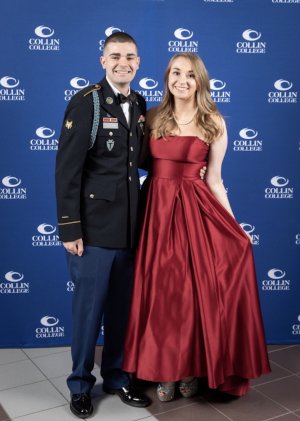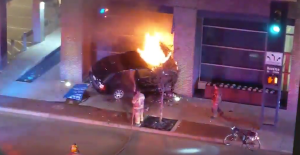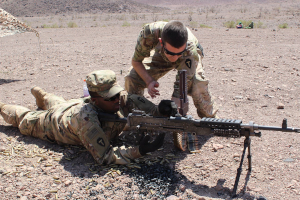Story by Brandon Jones, Texas Military Department Public Affairs
It was just another hot summer night for Texas Army National Guardsman Spc. Matt Oldham as he worked his civilian job, the overnight shift as a security guard at the Dallas Holocaust Museum, when an out-of-control car careened into a nearby building and burst into flames as he watched. Oldham knew he had to help. He ran to the burning car.
It wasn't too long ago, though, that Oldham walked the halls of Wylie High School in Wylie, Texas, figuring out what to do next with his life. Oldham says life can be pretty tough in a small town. Between classes, social pressures and uncertainty about college, he found a passion that stuck with him for a lifetime and helped him navigate the crash that night, as he put his military training to use. Oldham's desire to serve his country has always been his number one priority.
Oldham says that spirit of service comes from three generations of men in his family. Oldham's great grandfather, James Oldham, served in the U.S. Navy as a Seabee during World War II. His grandfather, Sgt. Bob Oldham, served multiple tours in Vietnam, receiving a Bronze Star for combat valor and a Purple Heart for wounds suffered in combat. Oldham's father, Sgt. Mark Oldham, spent time in Germany during the Cold War, in South Korea and at Dyess Air Force Base in Abilene, Texas.
 Spc. Matt Oldham and fiance Emma Sonck pose during a red carpet event hosted by Collin College. (Courtesy Photo: Army.com)
Spc. Matt Oldham and fiance Emma Sonck pose during a red carpet event hosted by Collin College. (Courtesy Photo: Army.com)
"The stories my family told me about serving were a life guide for me,” Oldham said. "I can't imagine a future without it."
It was just 20 days after his high school graduation in 2015 when Oldham joined that family tradition. He's now a SAW gunner in the 144th Infantry Regiment out of Seagoville, Texas, and his family couldn't be any prouder.
"When you realize the magnitude of the organization you have joined, it makes you want to grasp on to every piece of knowledge and apply it to your life," Oldham said.
Oldham deployed to the Horn of Africa from 2017-2018 after joining the National Guard. He describes the deployment as an opportunity to be a well-rounded Soldier. During his deployment, Oldham says he and other Soldiers learned airbase defense, patrols and general theater security.
"It's hard to imagine what you would do in a situation like that," Oldham said. “You try to push past it mentally, even though it's training because a real-life situation can be hard."
But Oldham had no idea he would put the skills learned during his deployment to the Horn of Africa to the test this past July. Oldham was three hours into his shift as a security guard for the Dallas Holocaust Museum when a loud sound forced him out of his seat. The sounds of glass breaking and tires screeching echoed in his ears as he made his way to see what was happening. As he got closer, Oldham noticed a man had crashed his vehicle into a downtown office building across the street from the museum, and the man's vehicle was now on fire.
Two Dallas Police Officers were already trying to do everything they could to save the man from the burning car. The entire front end of the man's SUV crunched against broken glass and bricks from the building, and the impact had trapped the man between the building and the car, according to Oldham.
"I had to act and participate in the rescue anyway I could," Oldham said. "If that were my family member, I would want someone to do the same."
 Firefighters respond to a crash near the Dallas Holocaust Museum where Spc. Matt Oldham works as a security officer. (Courtesy Photo: Robert McMurrey, Twitter)
Firefighters respond to a crash near the Dallas Holocaust Museum where Spc. Matt Oldham works as a security officer. (Courtesy Photo: Robert McMurrey, Twitter)
Oldham reached for his tourniquet, something he learned to carry at a first aid course he took during Initial Entry Training at Fort Benning, Georgia. He also took a Combat Lifesaver course his battalion medics taught. As part of the CLS class, Soldiers learned to use tourniquets, Israeli bandages, litters, chest seals, nasopharyngeal airways and more. Oldham recalled all of his training as he examined the driver for injuries.
"I could see several broken bones mostly in his feet and arms," Oldham said. "There were injuries to his chest as well. We were aware that this was a hazardous situation, and we needed to act fast."
As flames from the car intensified, Oldham could feel the sweat drop from his face and heat radiate throughout his body. He says he didn't think for a second about how he and the officers were putting themselves in harm's way. Oldham applied a tourniquet to the man's right foot as he helped pull him from the car.
"He seemed to be conscious even though he didn't say much," Oldham said. "I wanted to make sure he knew we were going to do everything we could to try to save him."
Seconds turned into what seemed like minutes during the rescue. The man was taken to the hospital and treated for his injuries. Dallas Police arrested the man for driving under the influence after the crash. Oldham feels everyone involved is fortunate the situation turned out as well as it did. Oldham says he was at the right place at the right time.
While Oldham insists he was just doing his job, Oldham is receiving awards to honor his heroism. The Dallas Holocaust Museum awarded him with The Lifesaver Award, and he's also receiving an award from his unit.
"When people walk up to me now they're saying I don't know if I would have been able to do that," Oldham said. “Life is short. It could all be over in an instant. I'm grateful for everyone one involved that night."
As he walks by the office building where the crash happened, all Oldham sees now are repairs. He wonders if he could have done more that night.
While some may consider Oldham a hero, he doesn’t see himself as one. Instead, he thinks of the generations of men in his family that served before him.
"If I could hear the words ‘well done’ by any of them, that's all I need," Oldham said.
 Spc. Matt Oldham assists a fellow member of the infantry in weapons training
Spc. Matt Oldham assists a fellow member of the infantry in weapons training
during a deployment to Arta, Djibouti. (Courtesy Photo: Spc. Matt Oldham)
This article originally appeared in the October 2019 edition of The Dispatch on page 10.